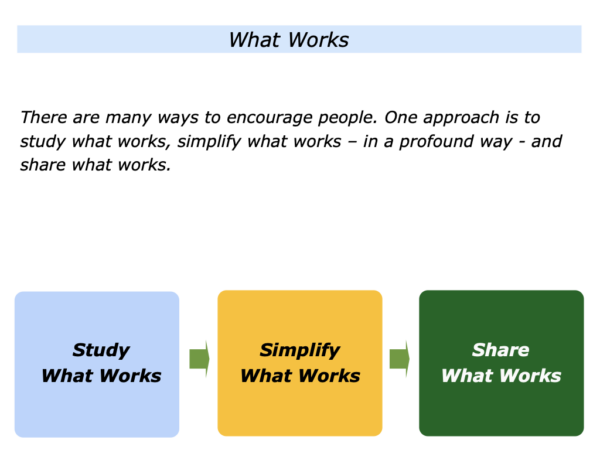
There are many ways to encourage people. One approach is to study what works, simplify what works – in a profound way – and share what works. It is then to provide people with practical tools they can use to follow these principles in their own ways.
Imagine that you want to follow this approach. You may want to apply the knowledge either: a) to reach your own goals; b) to help other people to reach their goals. This can involve exploring the following steps.
Studying What Works
The approach starts by focusing on a specific topic you want to learn about. Depending on your interests, you may want to explore one of the following themes.
I want to learn about:
How to be a good counsellor … How to help troubled teenagers … How to help people to build on their strengths and do satisfying work … How to coach young footballers … How to transform a negative culture into a positive culture … How to lead successful teams.
Imagine you have chosen the topic you want to explore. Bearing this in mind, you can ask yourself the following questions.
What works in this activity? How can I study success? When have people done superb in this activity? What did they do right then? What were the principles they followed? How did they translate these into action?
How can people follow these principles – plus maybe add other skills – in their own way? What are the key strategies they can follow to increase the chances of achieving success? What may be the pluses and minuses of following this approach?
This is an approach I followed when running therapeutic communities. I visited many programmes to see what worked when helping troubled teenagers. The staff and I then followed these principles in our own ways to help the young people.
Sports psychologists applied a similar approach from the 1970s onwards. They asked athletes to recall their best performances and what they did right. They then helped athletes to focus on how they could follow these principles – plus maybe add other skills – in the future.
David Cooperrider and Diana Whitney followed this path when creating Appreciative Inquiry. They invited people in organisations to clarify the principles they had followed to perform brilliantly in the past.
People then focused on how they could pursue these principles to do great work in the future. You can learn more about Appreciative Inquiry via the following link.
If you wish, try tackling the exercise on this theme. This invites you to do the following things.
Describe the specific activity where you would like to study what works.
Describe the specific things you can do to study what works in this activity.
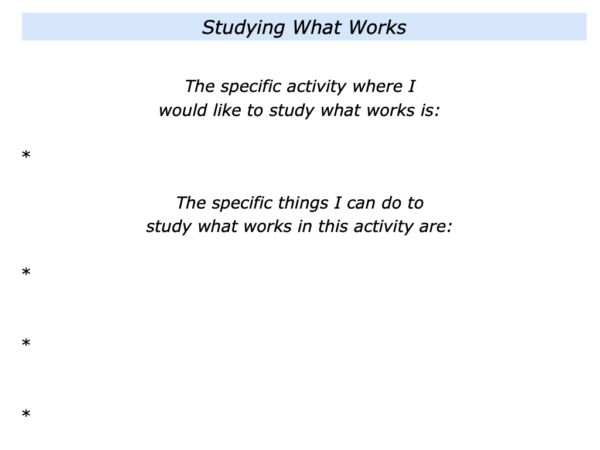
Simplifying What Works
Imagine that you have focused on a specific activity you want to learn about. The next step may be to simplify what works but to do this in a profound way. How to make this happen?
Great educators, for example, look for patterns in a specific activity. They take the following steps to study and simplify knowledge in a particular field.
They focus on what people do right – the successful patterns they follow – to achieve their picture of success;
They translate these patterns into principles that people can follow to achieve their picture of success;
They provide practical tools that people can use to follow these principles in their own ways to achieve their picture of success.
Great workers often demonstrate simplicity in action. A great dancer, footballer or artist can make executing the most difficult skill look deceptively easy. They make complicated things look simple. This is the result of combining their natural talent with years of practice.
Great educators who know their subject often demonstrate the second simplicity. Getting to the heart of the matter, they say things that are simple yet profound.
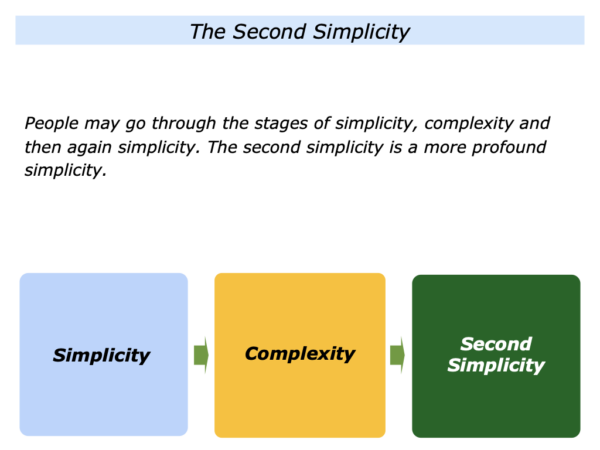
People sometimes go through the following stages in life: simplicity, complexity and again simplicity.
Simplicity
They start by seeing life – or the activity in which they are talented – as simple. Speaking with bravado, they state clearly what they believe to be true. Passionate about these beliefs, they demonstrate the idealism and confidence of youth.
Complexity
They may then enter the age of complexity. Gathering information, they become experts and speak in a more complex language. Sometimes they over-analyse. This does not help them or other people. Whilst still performing well, they feel something is missing.
Second Simplicity
Overcoming challenges, they enter another dimension. They may return to their original philosophy, but experience has brought wisdom. The pains and pleasures of life bring an extra timbre to their voice.
The second simplicity is a profound simplicity. Speaking from the depths of their being, their words resonate more deeply. They are real rather than in role. They have wisdom in their bones. Passing on what they have learned in life, they want to help others to succeed.
Different people choose different ways to simplify and share what works. Let’s look at one organisation that takes this route.
The Solutions Journalism Network
This organisation describes stories that provide practical hope. Here is their explanation of the difference between good stories and solutions journalism. Here is an introduction to its approach.
Good news stories focus on the vision, kindness or courage of someone doing something positive.
A common approach is to profile a person who had a personal awakening (often preceded by a personal crisis) which prompted him or her to quit a stable job to launch a charitable effort in a village in, say, Namibia.
The person finds new meaning and, though living on a shoestring, usually talks about being happier and more fulfilled. This kind of story can be heart-warming and authentic, but is usually delivered without much critical analysis.
Good news stories also rarely get people to think about systemic change. By contrast, solutions stories are driven by the problem solving – and rely on independent evidence to solve it.
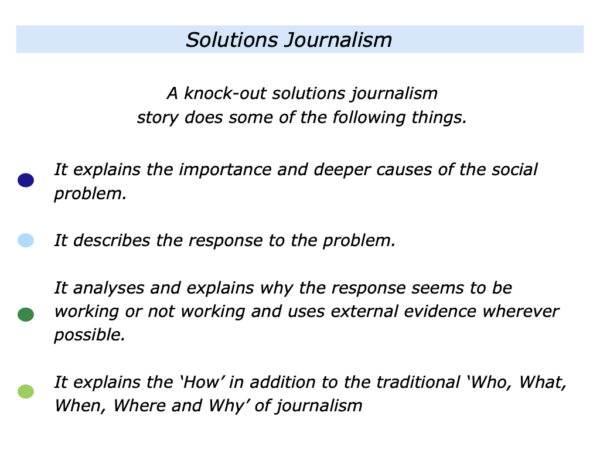
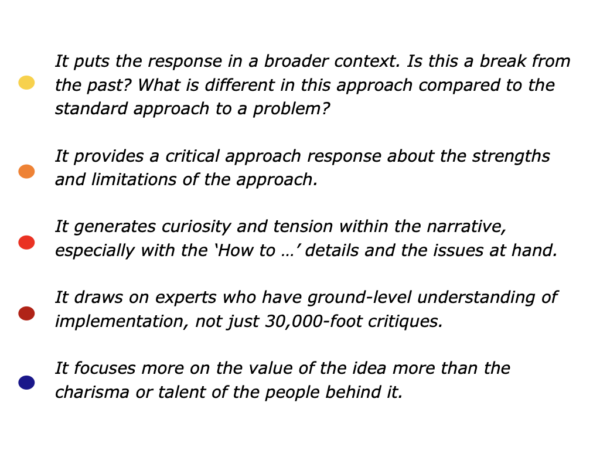
Like any good story, solutions journalism has interesting characters, action and tension, but they are constructed more like puzzles or mysteries than profiles or descriptive pieces.
The tension is not grounded in an argument, but in the inherent difficulty of changing a system or making an idea come to life. If told well, what gets revealed is often a little treasure of understanding – an insight about how the world works.
You will choose your own way to describe what works. Bearing in mind the activity you want to study, try tackling the exercise on this theme. Describe the specific things you can do to simplify what works in this activity.
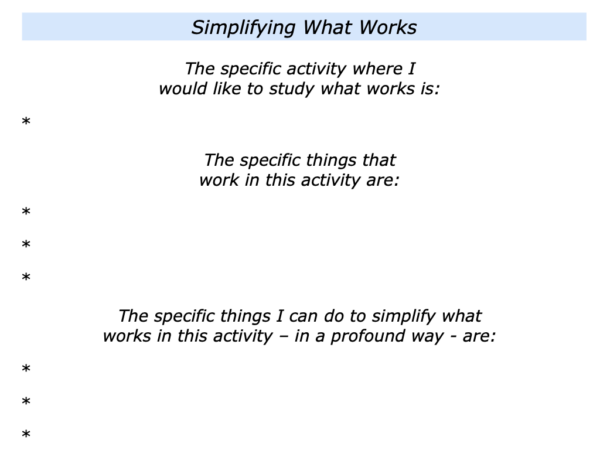
Sharing What Works
Imagine that you have clarified what works in a specific activity. As mentioned earlier, you may want to apply this knowledge to reach your own goals. Alternatively, you may to share what works to help other people to succeed.
Imagine that you want to take this second approach. One approach is to focus on the What, Who, Why, How and When. Let’s explore these themes.
The What
What is the specific activity you have studied? What works in this activity? What are the reasons why you may wanted to focus on this activity? What is the knowledge you want to pass on to people?
The Who
Who are the people you would like to reach? What are the characteristics of these people? Would they be young people, budding entrepreneurs, athletes, leaders, social entrepreneurs, therapists or other people?
The Why
Why would you like to pass on this knowledge? What would be the benefits for people? How can they use the knowledge to tackle challenges or achieve their goals?
The How
How would you like to share your knowledge with people? Bearing in mind your strengths, would you like to write articles, teach, run workshops, coach, mentor, make films or use another media?
The When
When do you want to share the knowledge with people? What would be the preferred setting or situation for passing on the ideas? How can you find or create a situation for passing on the knowledge?
Good educators often aim to study what works, simplify what works and share what works. You will follow these principles in your own way.
If you wish, try tackling the final exercise on this theme. This invites you to describe the specific things you can do to share what works with people. Here is the exercise.
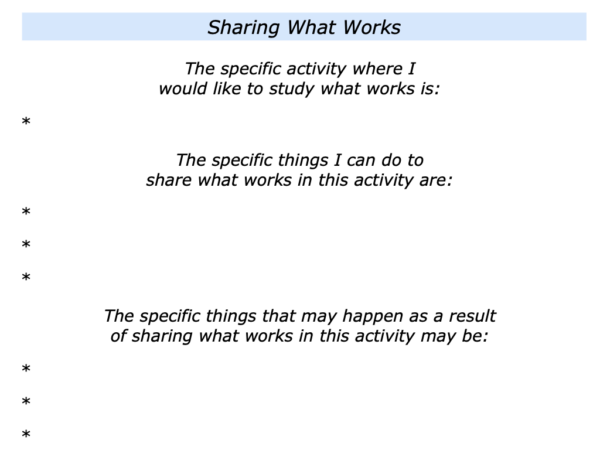






Leave a Reply